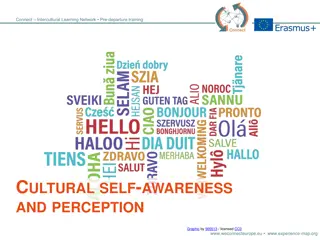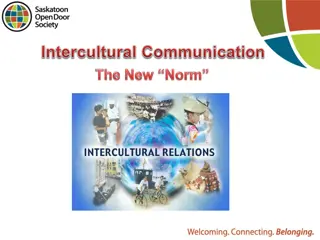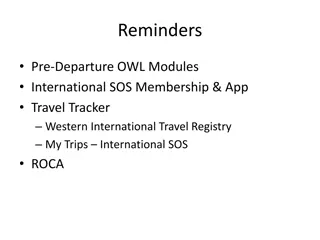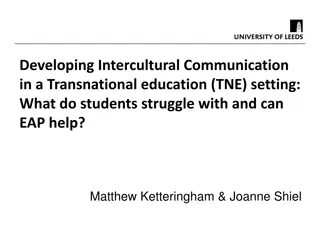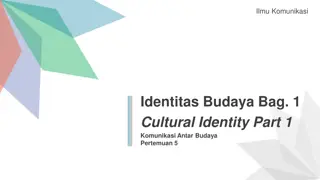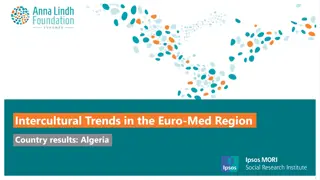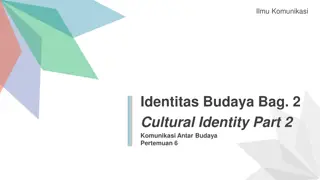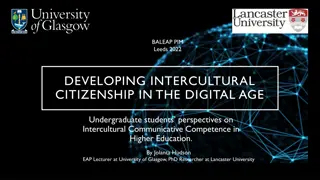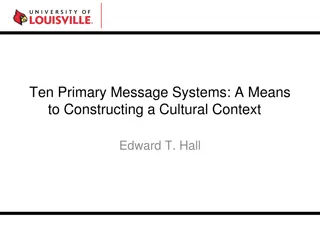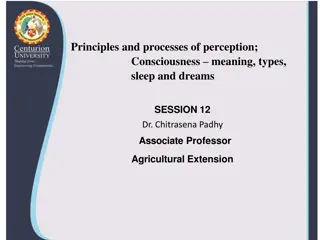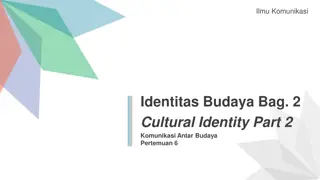Understanding Cultural Values and Perception in Intercultural Communication
Factors such as family, history, religion, and cultural identity significantly influence individuals' decision-making processes and behaviors. Cultural values play a crucial role in shaping perceptions and attitudes towards various issues and events, which can differ across cultures. Recognizing and managing these cultural differences is essential for successful intercultural communication. Perception is selective, learned, culturally determined, consistent, and sometimes inaccurate due to subjective influences. Understanding these characteristics is vital in navigating intercultural interactions effectively.
Download Presentation

Please find below an Image/Link to download the presentation.
The content on the website is provided AS IS for your information and personal use only. It may not be sold, licensed, or shared on other websites without obtaining consent from the author. Download presentation by click this link. If you encounter any issues during the download, it is possible that the publisher has removed the file from their server.
E N D
Presentation Transcript
Nilai Kebudayaan Komunikasi Antar Budaya Pertemuan 6-7
Factors such as family, history, religion, and cultural identity influence your decisions as to what to think about and how to act. What you think and how you react to events is based in part on how you perceive the world, which is strongly influenced by cultural values. What you consider important is often a product of values learned during childhood and these values motivate your behavior. Values are what give a culture its distinctive quality. Is there one God or many? Is it acceptable to burn the American flag? Would you eat whale meat? Samovar et all. 2010. Communication Between Cultures
The attitude you hold about an opinion, a moral issue, some question of ethics, a proposed course of action, or how to behave in a particular context is strongly influenced by cultural values, and your values can conflict with those from another culture. The ability to recognize and manage this conflict plays a central role in successful intercultural communication exchanges. Be aware of the impact of cultural values and provide understanding on how values can be different across cultures. To accomplish this we will (1) examine perception, (2) link perception to culture (3), briefly discuss values, and (4) look at different patterns, or dimensions, of cultural values. Samovar et all. 2010. Communication Between Cultures
UNDERSTANDING PERCEPTION A simple illustration of culture s influence on perception is what you see when looking at the moon. Most native born Americans will visualize a human face, but many American Indians, as well as Japanese, perceive a rabbit; the Chinese claim to see a lady fleeing her husband; and Samoans report a woman weaving. What is the cause of these very different views? The reason is perception how diverse cultures have taught their members to look at the world in different ways. Perception is how you make sense of your physical and social world, how you construct reality. perception is the process whereby people convert external events and experiences into meaningful internal understanding. Samovar et all. 2010. Communication Between Cultures
Characteristics of Perception - Alder and Gunderson - Perception is selective Because there are too many stimuli competing for the attention of your senses at the same time, you focus on selected information and filter out the rest. Perception is learned Life s experiences teach you to see the world in certain ways. Perception is culturally determined Culture teaches you the meaning of most of your experiences. Perception is consistent Once you perceive something in a particular manner that interpretation does not usually change. Perception is inaccurate You view the world through a subjective lens influenced by culture, values, and personal experiences, which tends to make you see what you want to see. Samovar et all. 2010. Communication Between Cultures
UNDERSTANDING VALUES What you believe in becomes the foundation for your values. What you find desirable for yourself and for the society you live in is a result of your values. For instance, people in the United States place great value on personal freedom and individual rights, and they think people all over the world should enjoy those same opportunities. In China, however, the conservative leadership sees social harmony and moral rectitude taking precedence over the individual. Samovar et all. 2010. Communication Between Cultures
The significance of values is that they inform members of a culture as to what is considered right and wrong, good and bad, correct and incorrect, appropriate and inappropriate, in almost every context of human endeavor. Institutionalized cultural values define what is worth dying for, what is worth protecting, what frightens people, what subjects are worthy of study, and which topics deserve ridicule. If you consider the other person strange, they probably consider you strange. Samovar et all. 2010. Communication Between Cultures
CULTURAL PATTERNS Cultural patterns can be seen as systems of integrated beliefs and values working in combination to provide a coherent, if not always consistent, model for perceiving the world. These patterns contribute to the way you see, think, and feel about the world and how you live in it. Samovar et all. 2010. Communication Between Cultures
HOFSTEDES VALUE DIMENSIONS Samovar et all. 2010. Communication Between Cultures
HOFSTEDES VALUE DIMENSIONS the first classification identifies six value dimensions individualism/ collectivism, uncertainty avoidance, power distance, masculinity/femininity, long-term/short-term orientation, indulgence/restraint Samovar et all. 2010. Communication Between Cultures
Individualism/ Collectivism Collectivistic cultures emphasize community, collaboration, shared interest, harmony, tradition, the public good, and maintaining face. Individualistic cultures emphasize personal rights and responsibilities, privacy, voicing one s own opinion, freedom, innovation, and self-expression. Individualists are likely to belong to many groups but retain only weak ties, changing membership when desired. In collective cultures, the individual is emotionally dependent on organizations and institutions, and group membership is emphasized. Organizations and the groups to which individuals belong also affect private life, and people generally acquiesce to group decisions, even if they are counter to personal desires. Samovar et all. 2010. Communication Between Cultures
Uncertainty Avoidance Though you may try, you can never predict with 100 percent assurance what someone will do or what might happen in the future. the extent to which the members of a culture feel threatened by ambiguous or unknown situations. Samovar et all. 2010. Communication Between Cultures
High Uncertainty Avoidance Low Uncertainty Avoidance They more easily accept the uncertainty inherent in life, tend to be tolerant of the unusual, and are not as threatened by different ideas and people. High uncertainty avoidance cultures endeavor to reduce unpredictability and ambiguity through intolerance of deviant ideas and behaviors, emphasizing consensus, resisting change, and adhering to traditional social protocols. These cultures are often characterized by relatively high levels of anxiety and stress. They prize initiative, dislike the structure associated with hierarchy, are willing to take risks, are flexible, think that there should be as few rules as possible, and depend not so much on experts as on themselves. People with this orientation believe that life carries the potential for continual hazards, and to avoid or mitigate these dangers, there is a strong need for laws, written rules, planning, regulations, rituals, ceremonies, and established societal, behavioral, and communication conventions, all of which add structure to life. As a whole, members of low uncertainty avoidance cultures are less constrained by social protocol. Samovar et all. 2010. Communication Between Cultures
Power Distance Classifies cultures on a continuum of high and low power distance (Some scholars use the terms large and small power distance). Power distance is concerned with how societies manage the fact that people are unequal. The concept is defined as, the extent in which the less powerful members of institutions and organizations within a country expect and accept that power is distributed unequally Samovar et all. 2010. Communication Between Cultures
High Power Distance Low Power Distance Individuals from high power distance cultures accept power as part of society. As such, superiors consider their subordinates to be different from themselves and vice versa Low power distance countries hold that inequality in society should be minimized. Subordinates and superiors consider each other as equals. Both consciously and unconsciously, these cultures teach their members that people are not equal in this world and that everybody has a rightful place, which is clearly marked by countless societal hierarchies. In low power distance work centers, you might observe decisions being shared, subordinates being consulted, bosses relying on support teams, and status symbols being kept to a minimum. Samovar et all. 2010. Communication Between Cultures
MASCULINITY/FEMININITY Masculinity Femininity Masculinity is the extent to which the dominant values in a society are male oriented. Cultures that value femininity as a trait stress nurturing behaviors. A society is called feminine when emotional gender roles overlap: Both men and women are supposed to be modest, tender, and concerned with the quality of life. A masculine oriented culture can be defined as, A society is called masculine when emotional gender roles are clearly distinct: men are supposed to be assertive, tough, and focused on material success, whereas women are supposed to be more modest, tender, and concerned with the quality of life. A feminine worldview maintains that men need not be assertive and that they can assume nurturing roles. It also promotes sexual equality and holds that people and the environment are important. Interdependence and androgynous behavior are the ideal, and people sympathize with the less fortunate. Samovar et all. 2010. Communication Between Cultures
LONG- AND SHORT-TERM ORIENTATION Long-term orientation stands for the fostering of virtues oriented toward future rewards in particular, perseverance and thrift. Its opposite pole, short-term orientation, stands for the fostering of virtues related to the past and present in particular, respect for tradition, preservation of face, and fulfilling social obligations Samovar et all. 2010. Communication Between Cultures
LONG TERM ORIENTATION SHORT TERM ORIENTATION Corporate organizations in cultures that rank high on the long-term orientation scale, such as in China and South Korea, would be characterized by a focus on: obtaining market share, rewarding employees based on organizational loyalty, strong interpersonal connections, situational ethics, adaptability, and self-discipline. Leisure time would not be a central concern. In contrast, organizations possessing a short-term orientation, like those in Mexico, the U.S., and Egypt, would emphasize: short-term profits, use merit to reward employees, experience transient organizational loyalty, and consider ethics to be based on a set of universal principles. Personal freedom and leisure time would be a significant value. Samovar et all. 2010. Communication Between Cultures
INDULGENCE/RESTRAINT INDULGENCE RESTRAINT reflects a conviction that such gratification needs to be curbed and regulated by strict social norms Indulgence stands for a tendency to allow relatively free gratification of basic and natural human desires related to enjoying life and having fun. members of a restrained society would feel they had less freedom to enjoy themselves, consider frugality to be important, and that social order and discipline were more important than individual freedoms In an indulgent society, people will place a priority on their sense of freedom and personal enjoyment through leisure time and interacting with friends. Consumption and spending would take precedence over fiscal restraint. receiving a smile from a stranger would be viewed with suspicion In indulgent cultures, individuals are encouraged and expected to smile at everyone Samovar et all. 2010. Communication Between Cultures
KLUCKHOHN AND STRODTBECKS VALUE ORIENTATIONS Samovar et all. 2010. Communication Between Cultures
KLUCKHOHN AND STRODTBECKS VALUE ORIENTATIONS After extensive study, they concluded that all people turn to their culture to help them in answering the same five basic questions: 1. What is the character of human nature? 2. What is the relation of humankind to nature? 3. What is the orientation toward time? 4. What is the value placed on activity? 5. What is the relationship of people to each other? Samovar et all. 2010. Communication Between Cultures
HUMAN NATURE ORIENTATION For centuries, religious leaders, philosophers, scholars, and others have pondered questions concerning human nature, answers to which represent a powerful force in how one lives life. Although all people individually answer questions about human nature, there are also cultural explanations for why people act as they do. Samovar et all. 2010. Communication Between Cultures
Evil Good and Evil Good Some cultures believe that people are intrinsically evil. People holding a Taoist worldview believe the universe is best seen from the perspective of yang and yin, an infinite system of opposing elements and forces in balanced, dynamic interaction. Perhaps the most extreme view of the innate goodness of human nature is found in the philosophies of Confucianism and Buddhism. According to the Lu Wang school of Confucianism, Human nature is originally good. According to this idea, with constant hard work, control, education, and self- discipline, people can achieve goodness. Buddhism also maintains that you are born pure and are closest to what is called loving kindness when you enter this world. Hence, people are good, but their culture often makes them evil. This view of the good and evil nature of humanity proposes that people cannot eliminate evil, because it is an integral part of the universe. you can find cultures that are imbued with the notion that people have a penchant for evil and therefore cannot, when left to their own resources, be trusted to make a correct decision. Samovar et all. 2010. Communication Between Cultures
PERSON/NATURE ORIENTATION Humans Subject to Nature Cultures holding this orientation believe the most powerful forces of life are beyond control. Master of Nature the view that compels us to conquer and direct the forces of nature to our advantage. Harmony with Nature This orientation affirms that people should, in every way possible, live in harmony with nature. Whether the force is a god, fate, or magic, it cannot be overcome and must therefore be accepted. People with this orientation see a clear separation between humans and nature. Samovar et all. 2010. Communication Between Cultures
TIME ORIENTATION Past Orientation In past-oriented cultures, history, established religions, and tradition are extremely important. Present Orientation Present-oriented cultures hold that the immediate moment carries the most significance. Future Orientation In future-oriented cultures, what is yet to come is most valued and the future is expected to be grander than the present or past. The future is seen as ambiguous, capricious, and, in a sense, beyond the control of the individual. There is an intense belief that contemporary perceptions of people and events, decision making, and determinations of truth should be guided by what happened in the past. Change, taking chances, a stress on youth, and optimism are all hallmarks of cultures that hold this orientation. Because the past is over and the future is unpredictable, present cultures, such as Filipinos and Latin Americans, enjoy living in the moment. Samovar et all. 2010. Communication Between Cultures
ACTIVITY ORIENTATION Being Being-in-Becoming Being-in-becoming stresses the idea of development and growth. Doing A being orientation refers to spontaneous expression of the human personality. The doing orientation describes activity in which accomplishments are measurable by standards external to the individual. People in being- orientated cultures accept people, events, and ideas as flowing spontaneously. It emphasizes the kind of activity that contributes to the development of all aspects of the self as an integral whole. The key to this orientation is a value system that stresses activity and action. They stress release, indulgence of existing desires, and working for the moment. This usually correlates with cultures that value a spiritual life over a material one. Samovar et all. 2010. Communication Between Cultures
HALLS HIGH-CONTEXT AND LOW-CONTEXT ORIENTATIONS Samovar et all. 2010. Communication Between Cultures
HALLS HIGH-CONTEXT AND LOW- CONTEXT ORIENTATIONS A high-context (HC) communication or message is one in which most of the information is already in the person, while very little is in the coded, explicitly transmitted part of the message. A low-context (LC) communication is just the opposite; i.e., the mass of the information is vested in the explicit code Samovar et all. 2010. Communication Between Cultures
High Context Low Context In low-context cultures, the verbal message contains most of the information and very little is embedded in the context or the participant s nonverbal activity. In high-context cultures, most of the meaning exchanged during an encounter is often not communicated through words. One reason that meanings frequently do not have to be stated verbally in high-context cultures is because there is normally a strong level of similitude among the people. Western communication (low-context) tends to be direct and explicit. Because meaning is not necessarily contained in words, in high- context cultures, information is provided through inference, gestures, and even silence. They think it is important to be able to speak up and say what s on their mind Samovar et all. 2010. Communication Between Cultures
In high-context cultures, people who rely primarily on verbal messages for information are perceived as less credible. They believe that silence often sends a better message than words, and that anyone who needs words does not have the requisite information. As the Indonesian proverb states, Empty cans clatter the loudest. Samovar et all. 2010. Communication Between Cultures
Question? Thank you Samovar et all. 2010. Communication Between Cultures




